
Call now for a confidential consultation with our Patient Representative • Atlanta & Beverly Hills 678-573-6965
About Laparoscopic Vesicovaginal Fistula Repair
What is a bladder or vesicovaginal fistula?
A fistula is an abnormal connection between organs. A vesicovaginal fistula is an abnormal connection between the bladder (vesico) and the vagina.
What causes vaginal fistulas?
This type of vaginal fistula usually occurs during the healing process after a hysterectomy, infant delivery (vaginal or Cesarean), cancer operations, or radiation therapy.
Predisposing conditions for fistula formation include previous surgery, diabetes, smoking, cancer, or steroid use. The majority of the fistulas that occur in the United States are due to abdominal surgery (especially abdominal hysterectomies). A fistula repair surgery can close up a vaginal fistula.
Vaginal fistula Indications
Patients with vaginal fistulas usually present 1 to 3 weeks after a gynecologic surgery with complaints of continuous urinary incontinence, vaginal discharge, pain or an abnormal urinary stream. After a complete physical examination, the doctors are usually able to confirm the diagnosis of fistula. However, sometimes it is necessary to perform additional x-ray studies to ascertain whether there is more than one fistula or whether the fistula may involve other organs. Once a complete evaluation has been performed and the diagnosis established, the surgeons at Atlanta Urogynecology Associates will discuss the surgical options with you.

Advantages of Laparoscopic Fistula Repair with Drs. Miklos and Moore
Drs. Miklos and Moore perform both transvaginal and laparoscopic fistula repair surgery. Many patients that are seen in their center have had multiple previous surgical attempts through the vagina and now are faced with a final attempt at repair through a large abdominal incision (aka laparotomy). By utilizing the minimally invasive approach known as laparoscopic fistula repair surgery, Drs. Miklos and Moore can repair fistulas with greater detail and complete visualization than either by the vaginal or abdominal approach. Many physicians repair fistulas through the vagina, but if the fistula persists after a vaginal repair, the defect occurs very high at the vaginal apex near the bladder. This is where the laparoscopic approach can help in the repair. Dr. Miklos has a series of publications dealing with laparoscopic management of vesicovaginal fistula repairs and vesicouterine fistula repair.
It is very important to repair the vesicovaginal fistula correctly on the first attempt. Our success rate is comparable to one of the largest studies of 303 patients at the Mayo Clinic. A testament to Dr. Miklos' approach and success can be found in that urogynecologists, urologists and gynecologists have referred patients from Indiana , Pennsylvania , Georgia and Alabama for laparoscopic repair of previously failed fistula surgeries.
Bladder Fistula Surgical Repair Technique
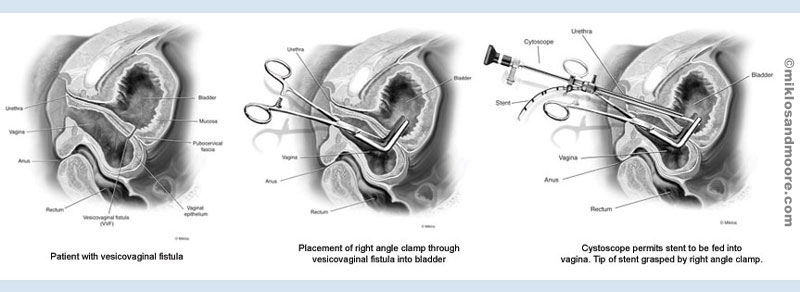
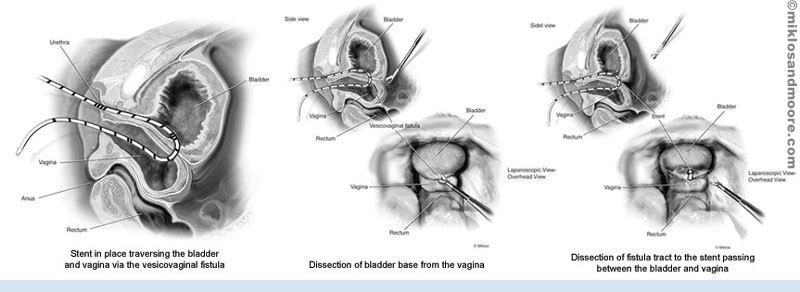
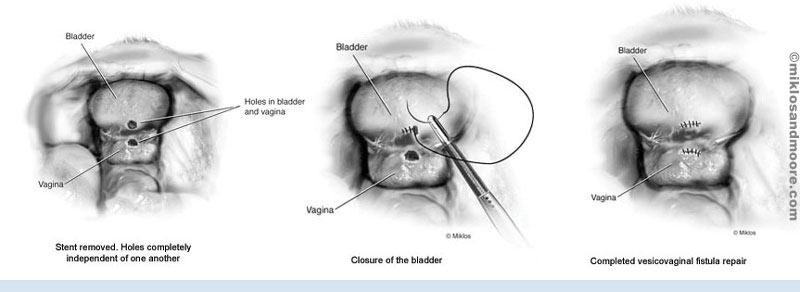
Here are some pictures taken during a Fistula Repair Surgery:
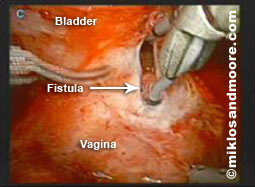
Picture 1--shows opening the fistula tract with
the bladder above and the vagina below
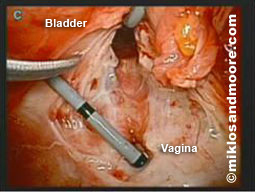
Picture 2--shows the separation of the stent
and the fistula; the hole above is the bladder
and the one below is the vagina
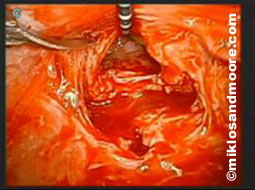
Picture 3—shows the hole in the bladder after
cutting away the fistula scar of the bladder
(now it appears larger than before)
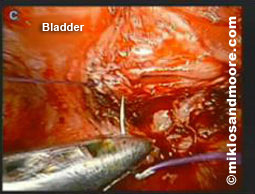
Picture 4—shows closing the edges of the
bladder using a suture and needle
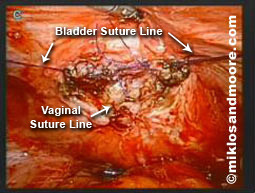
Picture 5---shows the placement of our 6th
suture (out of 7) closing the bladder hole in an
area of less than 1 inch (this is the first line of
closure, we reinforced this closure with a
second layer of sutures)

Picture 6—shows a bladder full of water
testing the integrity of our surgical repair. We
tested the tightness of the repair only after
doing a two layer closure on the bladder.
Possible Complications of Fistula Repair
Patients undergoing a vaginal fistula repair surgery can experience intra and post operative complications including, but not limited to, the following:
- Post Operative Failure
- Recurrent Fistula Formation
- Injury to Ureter, Bowel, or Intestines
- Vaginal Shortening
Though many institutions where vesicovaginal fistulas are repaired would also state that vaginal shortening is a potential complication, this is minimized and a rarity when performing vesicovaginal fistula repair laparoscopically.
Because most patients with fistulas have had previous fistula surgery, a laparoscopic fistula repair can be a complex procedure. Our success rate is greater than 90%. Some patients referred to us have had more than 3 previous attempts at vesicovaginal fistula repair, but after one laparoscopic approach, they have been cured of their fistula and its symptoms.
Atlanta Urogynecology Associates Experience with Fistula Repair
Drs. Miklos and Moore have performed laparoscopic vesicovaginal fistula repairs over the past 6 years with great success. We believe that the laparoscopic approach is beneficial in order to properly excise a vaginal fistula. The minimally invasive laparoscopic vesciovaginal fistula surgery is a safe and effective way to excise the abnormal connections that affect your lifestyle. You usually go home the next day and experience little or no pain. A PubMed search of laparosccxopic vesicovaginal fistula repair shows very few physicians with as much experience as Drs. Miklos and Moore.



